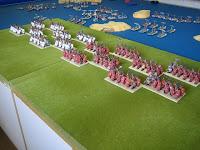
I have just returned from a trip to Moscow. Primarily this was a trip to see my brother-in-law Rupert and his family who have recently moved to live there. However, my passion for things military being what it is, it would have been remiss of me not to slip in some visits to a few history museums and a battlefield. As well as planned excursions, Russia is littered with military bits and pieces - roadside tanks etc. Above, my son meets some (bribed)
Streltsi in Red Square.


THE
BORODINO PANORAMA MUSEUM


This is a fantastic small museum just down the road from the Great Patriotic War Museum. It has a number of small exhibits and models, but at its centre is the panorama (you stand in the middle) of the battle. This is cleverly done with a 1:1 scale diorama in the fore ground and the painting of the battle behind it.







THE
BORODINO MUSEUM AT
BORODINO
Rupert (who is also interested in history) had arranged for his driver to take us both to
Borodino on the last full day of my visit. It was the military highlight of my trip. By road this is about 120km drive west of central Moscow. Be warned that, because of the horrific traffic in Moscow, this distance takes about two and a half hours each way! However, it is well worth a visit. It has a well appointed (if small) museum opposite the memorial sited at the Great Redoubt. The museum is crammed with interesting exhibits including a large diorama of the battlefield and
Kutusov's carriage. It is the ideal place to start, get your bearings and pick up a tour map.


 BORODINO
BORODINO FIELD

The battlefield itself has memorials to the (Russian only) fighting formations at their main positions. Although roadside trees now obscure the view from the Russian to the French positions, the battlefield is largely unspoilt.



From the Great Redoubt looking west, looking east and looking north east.


Looking north to the Great redoubt from the midway point between it and the
Bagration Fleches, and the
Semenkovka stream (which looks like a series of muddy ponds).



The
Bagration Fleches (forward?) looking west, looking south, and from the rear. These look like they are modern reconstructions.

Although built in the mid 19C the convent at the
Bagration fleches houses one within its grounds. It also has a small museum (disappointing). The convent church is well worth a visit - stunning inside and out. (Rupert centre and his driver Gregory on the left).
THE GREAT PATRIOTIC WAR MUSEUM







VISITING MOSCOW
Moscow is a city of extremes. It has some wonderful architecture amongst the endless communist high rise apartment blocks; it needs a lot of TLC and some health and safety legislation.
Eating well, etc. is very, very pricey - much more expensive than London and there is no middle ground. Expect a simple 'western' lunch to set you back £15 and a good dinner 4 or 5 times that. Only Petrol and take out booze are inexpensive. All museums have a very reasonable entry fee (£1 - £3) and all allow photography provided you pay for the extra photography ticket.
My honest opinion of Moscow as a whole is that it is worth a visit once - so get everything you need to do done in a single visit. It is an edgy, dirty, wholly corrupt and moth eaten city - after visiting (save for family and friends) you probably will not want to return.























































































